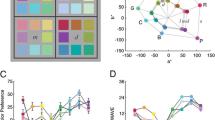Abstract
The authors review existing color choice data concerning a decline through childhood in a bias for novelty and intransitive choice linked to novelty. They report a sex difference in which females, across age, are found to exceed males in novelty bias, but not in intransitivity. Results are reported for two new studies designed to assess the generality of the novelty-intransitivity relation by testing with choice materials other than colors. Responses of six-, eight-, and ten-year olds to line drawings were consistent with the model based on color choice, except that no differences between the sexes were found. In contrast to earlier findings adults responding to photographs of faces showed a marked aversion to novelty and much lower levels of intransitivity. Results are taken as supportive of Zajonc's case for a separation between cognitive and aesthetic aspects of mental organization and are related to the mere exposure effect.
Similar content being viewed by others
References
D.E. Berlyne,Aesthetics and Psychobiology (Appleton-Century-Crofts, New York, 1971).
H. Bradbury, Consistency of children's inconsistent preferences attributable to novelty, Develop. Psychol. 11(1975)9–866.
H. Bradbury and T.M. Nelson, Transitivity and the patterns of children's preferences, Develop. Psychol. 10(1974)55–64.
H. Bradbury and M. Moscato, Development of transitivity of preference: Novelty and linear regularity, J. Genetic Psychol. 140(1982)265–281.
H. Bradbury and C. Plichon, The relative weakness of novelty in children's choices, J. Genetic Psychol. 139(1981)233–244.
H. Bradbury, L. Shewfelt and R. Gjerek, Intransitivity of preferences of four-year-old children, J. Genetic Psychol. 145(1984)145–146.
C.H. Coombs, On the use of inconsistency of preferences in psychological measurement, J. Exp. Psychol. 55(1958)1–7.
A. Tversky, Intransitivity of preferences, Psychol. Rev. 76(1969)31–48.
R.B. Zajonc, Attitudinal effects of mere exposure, Journal of Personality and Social Psychology Monograph, 9(1968). (2, Part 2).
R.B. Zajonc, Feeling and thinking: Preferences need no inferences, Amer. Psychol. 15, 2(1980)151–175.
Author information
Authors and Affiliations
Rights and permissions
About this article
Cite this article
Bradbury, H., Ross, K. The effects of novelty and choice materials on the intransitivity of preferences of children and adults. Ann Oper Res 23, 141–159 (1990). https://doi.org/10.1007/BF02204843
Issue Date:
DOI: https://doi.org/10.1007/BF02204843




